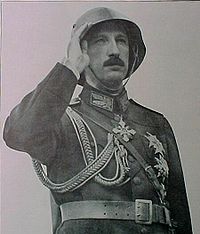
Bulgarian M36 Helmet
Encyclopedia

Bulgarian language
Bulgarian is an Indo-European language, a member of the Slavic linguistic group.Bulgarian, along with the closely related Macedonian language, demonstrates several linguistic characteristics that set it apart from all other Slavic languages such as the elimination of case declension, the...
: Каска М36) was the basic helmet
Helmet
A helmet is a form of protective gear worn on the head to protect it from injuries.Ceremonial or symbolic helmets without protective function are sometimes used. The oldest known use of helmets was by Assyrian soldiers in 900BC, who wore thick leather or bronze helmets to protect the head from...
of the Bulgarian Army prior to the outbreak of World War II
World War II
World War II, or the Second World War , was a global conflict lasting from 1939 to 1945, involving most of the world's nations—including all of the great powers—eventually forming two opposing military alliances: the Allies and the Axis...
and during the Bulgarian participation in the war
Military history of Bulgaria during World War II
The military history of Bulgaria during World War II encompasses an initial period of neutrality until 1 March 1941, a period of alliance with the Axis Powers until 9 September 1944 and a period of alignment with the Allies until the end of the war. Bulgaria was a constitutional monarchy during...
. Its latest variant is still in service along with several different modern helmets.
History and variants
During World War IWorld War I
World War I , which was predominantly called the World War or the Great War from its occurrence until 1939, and the First World War or World War I thereafter, was a major war centred in Europe that began on 28 July 1914 and lasted until 11 November 1918...
Bulgarian soldiers were equipped with the German Stahlhelm M1916, which remained in service up to the end of 1930s. The restrictions imposed on the Bulgarian Army by the Treaty of Neuilly-sur-Seine of 1919 were overcome in the mid 1930s and in 1935 the High Command ordered the design of a new army helmet. At the end of 1935 the prototype was ready and subsequently approved in 1936.
The general design was distantly reminiscent of the Stahlhelm, but with some considerable alterations. The general structure and depth were similar, but the brim was shortened, opened wider and more gradually turned. The ventilation apertures were retained, but set in smaller rounded fittings. The angles of the side and upper surfaces were conically increased with aim to cause hits of over 90o to ricochet. From mid-front to mid-rear a well-pronounced projecting rib was shaped. As result the helmet received a very distinctive outline with only a distant likeness to the Stahlhelm. It was made of steel with only a small quantity of the first model made of lighter laminated iron, exclusively as officers' dress gear. The edges of the shell were rolled over in the earliest type known as A, while on the later type known as B these were straight cut. In 1939 a new redesigned version with shallowed shell and shortened brim, known as type C, was brought into service. An estimated 70% of all production was of this third model. Factory-issued helmets were initially dark greyish-green in colour with a small shield in Bulgarian flag colours on the right. Later new brighter pea-green shade was introduced. The leather suspension, or liner, were produced in several different variants. The M36 helmet design became lighter, more compact, and more comfortable than the First World War-era designs and provided excellent protection.
It was introduced in regular service in 1936. Initially, production began outside Bulgaria
Bulgaria
Bulgaria , officially the Republic of Bulgaria , is a parliamentary democracy within a unitary constitutional republic in Southeast Europe. The country borders Romania to the north, Serbia and Macedonia to the west, Greece and Turkey to the south, as well as the Black Sea to the east...
in three foreign factories: Sandrik in Dolne Hamre and Bruder Gottlieb und Brauchbar in Brun, Moravia (Bratri G&B - Brno) in Czechoslovakia
Czechoslovakia
Czechoslovakia or Czecho-Slovakia was a sovereign state in Central Europe which existed from October 1918, when it declared its independence from the Austro-Hungarian Empire, until 1992...
and Eisenhuttenwerk Thale in Thale, Harz, Germany. In the end of 1935 a punching press was imported from Germany to Bulgaria and installed at the Military Works in the town of Kazanlak
Kazanlak
Kazanlak, formerly Kazanlık is a Bulgarian town in Stara Zagora Province, located in the middle of the plain of the same name, at the foot of the Balkan mountain range, at the eastern end of the Rose Valley...
, and subsequently production continued in Bulgaria as well. The earlier bigger and heavier types A and B were phased out in the early 1950s, but the latest type C is still in service in the Bulgarian army.

